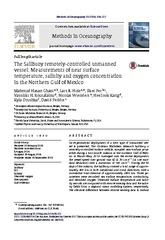| dc.contributor.author | Ghani, Mahmud Hasan | eng |
| dc.contributor.author | Hole, Lars R | eng |
| dc.contributor.author | Fer, Ilker | eng |
| dc.contributor.author | Kourafalou, Vassiliki H. | eng |
| dc.contributor.author | Wienders, Nicolas | eng |
| dc.contributor.author | Kang, HeeSook | eng |
| dc.contributor.author | Drushka, Kyla | eng |
| dc.contributor.author | Peddie, David | eng |
| dc.date.accessioned | 2015-03-23T14:04:43Z | |
| dc.date.available | 2015-03-23T14:04:43Z | |
| dc.date.issued | 2014-09 | eng |
| dc.identifier.issn | 2211-1220 | en_US |
| dc.identifier.uri | https://hdl.handle.net/1956/9619 | |
| dc.description.abstract | An experimental deployment of a new type of unmanned vessel is presented. The Christian Michelsen Research SailBuoy, a remotely-controlled surface vehicle, sampled near-surface properties during a two-month mission in the northern Gulf of Mexico in March–May, 2013. Averaged over the entire deployment, the vessel speed over ground was View the MathML source42±30cm s⎻¹ (± one standard deviation) with a maximum of View the MathML source180cm s⎻¹. During the 62 days of the mission, the SailBuoy covered a total range of approximately 400 km in both meridional and zonal directions, with a cumulative total distance of approximately 2400 km. Three parameters were recorded: sea surface temperature, conductivity, and dissolved oxygen. Observed surface temperature and salinity records are compared with remote sensing data and the salinity fields from a regional ocean modeling system, respectively. The absolute difference between remote sensing data to surface temperature is on an average approximately 0.5 °C. The comparison with the full Gulf of Mexico and the nested Northern Gulf of Mexico HYCOM models demonstrates the validity and usefulness of SailBuoy measurements and the instrument’s utility in evaluating fields produced by ocean models having different attributes. The potential of the SailBuoy for mapping a large-scale river plume, which would be challenging or costly with conventional ship surveys and/or remote sensing, is demonstrated. | en_US |
| dc.language.iso | eng | eng |
| dc.publisher | Elsevier | en_US |
| dc.rights | Attribution-NonCommercial-NoDerivs CC BY-NC-ND | eng |
| dc.rights.uri | http://creativecommons.org/licenses/by-nc-nd/3.0/ | eng |
| dc.subject | SailBuoy | eng |
| dc.subject | SST | eng |
| dc.subject | Salinity | eng |
| dc.subject | Dissolved oxygen | eng |
| dc.subject | River plumes | eng |
| dc.subject | Gulf of Mexico | eng |
| dc.title | The SailBuoy remotely-controlled unmanned vessel: Measurements of near surface temperature, salinity and oxygen concentration in the Northern Gulf of Mexico | en_US |
| dc.type | Peer reviewed | |
| dc.type | Journal article | |
| dc.date.updated | 2015-03-04T09:43:32Z | en_US |
| dc.description.version | publishedVersion | en_US |
| dc.rights.holder | Copyright 2014 The Authors | en_US |
| dc.identifier.doi | https://doi.org/10.1016/j.mio.2014.08.001 | |
| dc.identifier.cristin | 1149354 | |
| dc.source.journal | Methods in oceanography | |
| dc.source.40 | 10 | |
| dc.source.pagenumber | 104-121 | |
| dc.subject.nsi | VDP::Mathematics and natural scienses: 400::Geosciences: 450::Meteorology: 453 | en_US |
| dc.subject.nsi | VDP::Matematikk og naturvitenskap: 400::Geofag: 450::Meteorologi: 453 | nob |

